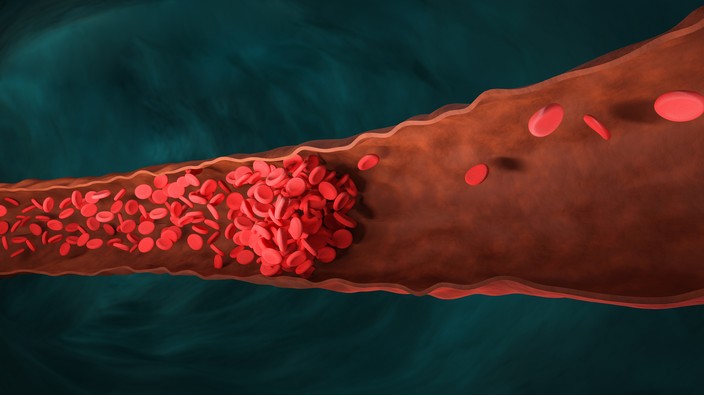blood clots: do you know the signs?
some risk factors for developing a blood clot include major surgery, a broken leg or hip bone, as well as varicose veins.

blood clots are most common among adults who are 60 years of age or older but they can happen at any age and affect around five per cent of people in their lifetime, the ottawa hospital research institute reports. getty
blood clots, otherwise known as venous thromboembolism (vte), are a serious medical condition that occurs when an abnormal blood clot forms in a vein. the disorder, which is the third most common cause of vascular mortality in the world (behind heart attacks and strokes), encompasses deep-vein thrombosis (dvt) and pulmonary embolism (pe), reports the canadian patient safety institute. deep-vein thrombosis refers to clots that form deep inside a vein in the leg, while pulmonary embolisms occur when all or part of a dvt breaks free from the wall of a vein and migrates to the lungs, where it can impede or block the supply of air. blood clots that originate in the thigh are more likely to become a pulmonary embolism than those in the lower leg or other areas of the body.
symptoms of blood clots
the symptoms of vte vary by patient, with some experiencing no symptoms at all until the arrival of major complications, according to the national heart, lung and blood institute. in cases of dvt, patients may experience increased warmth, red or discoloured skin and pain or swelling in the area of the clot, which is usually in the calf or thigh. if a dvt breaks off and becomes a pulmonary embolism, patients may experience shortness of breath or rapid breathing, pain while breathing deeply and an increased heart rate. less common symptoms of a pe include light-headedness or feeling faint and coughing (with or without blood). you should contact your doctor immediately if you think you may be experiencing symptoms of vte.
advertisement
diagnosing blood clots
doctors typically rely on a patient’s recent medical history when diagnosing blood clots, with an emphasis on any medications they may be taking, surgeries they have had, past cancer treatments or any paralysis or extended periods of time without movement. they will likely perform a physical exam to test a patient’s heart rate and inspect any area exhibiting symptoms. a number of other procedures may be prescribed, including:
- d-dimer test – this can detect the presence of clotting activity in the blood
- ultrasound – uses sound to produce pictures of blood flowing through veins and searches for clots
- ct angiography – the most commonly used diagnostic tool for a pulmonary embolism, this test can take pictures of blood vessels and find clots in the legs and lungs
- pulmonary angiography – used to confirm a pe through x-rays and a tube that is inserted into blood vessels
treating blood clots
deep-vein thrombosis and pulmonary embolisms are usually life-threatening conditions and, depending on the area and severity of the clot, can require immediate attention, according to the american heart association. treatment typically involves:
- blood thinners (or anticoagulants) – used to prevent clots from forming or growing larger
- thrombolytic inhibitors – often used for people who can’t take certain blood thinners, this type of drug dissolves clots and interferes with clot formation by inhibiting the activity of a naturally occurring enzyme called thrombin
- surgical thrombectomy – in some cases, surgery may be required to remove blood clots
advertisement
how to prevent a blood clot
there is usually more than one risk factor involved when a person develops a blood clot, with the risk elevating alongside the number of factors. some of these include: major surgery (such as hip or knee replacement); a broken leg or hip bone; cancer; spinal cord injury; or stroke, heart attack or heart failure. obesity, age, family history, varicose veins, sickle cell disease and infections (including from sars-cov-2, the virus that causes covid-19) are also risk factors.
doctors often prescribe three measures to help high-risk patients reduce their risk:
- motion – movement keeps blood circulating and makes it harder for clots to form. patients who are unable to walk are encouraged to flex their feet and legs to keep blood in motion
- pressure – light pressure, through compression stockings or special sleeves or boots, keeps blood moving and prevents clotting
- blood thinners – stops clots from forming or growing larger
prevalence of blood clots
blood clots are most common among adults who are 60 years of age or older but they can happen at any age and affect around five per cent of people in their lifetime, the ottawa hospital research institute reports. deep-vein thrombosis occurs in around 200,000 canadians every year, with about 60,000 requiring hospitalization on an annual basis. pulmonary embolism is the leading cause of maternal death associated with childbirth and a woman’s risk of developing a blood clot is six times greater during pregnancy.
advertisement
support for managing blood clots
if you or someone you know is dealing with blood clots, there are a number of support groups available to help, including the blood clot recovery discussion group and blood clots: surviving a silent killer.
dave yasvinski is a toronto-based writer.
thank you for your support. if you liked this story, please send it to a friend. every share counts.
 4 minute read
4 minute read





